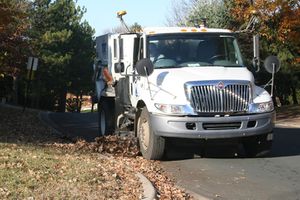
Difference between revisions of "Street sweeping"
m () |
m () |
||
| Line 1: | Line 1: | ||
== == | == == | ||
| − | |||
[[File:Street-sweeping.jpg|300px|thumb|alt=image of street sweeper|<font size=3>Image courtesy Sarah Hobbie, University of Minnesota</font size>]] | [[File:Street-sweeping.jpg|300px|thumb|alt=image of street sweeper|<font size=3>Image courtesy Sarah Hobbie, University of Minnesota</font size>]] | ||
| + | ==Information on street sweeping== | ||
*[[Overview of street sweeping]] | *[[Overview of street sweeping]] | ||
*[[Recommended street sweeping practices for water quality purposes]] - <span title="This page contains information summarizing recommended sweeping practices, typically to maximize pollutant removal. Examples include when to sweep, recommended equipment, managing sweeping material, cost information, etc. The current TTech work order will provide some of this information."> '''Coming in summer, 2021'''</span> | *[[Recommended street sweeping practices for water quality purposes]] - <span title="This page contains information summarizing recommended sweeping practices, typically to maximize pollutant removal. Examples include when to sweep, recommended equipment, managing sweeping material, cost information, etc. The current TTech work order will provide some of this information."> '''Coming in summer, 2021'''</span> | ||
*Pollutant removal associated with street sweeping | *Pollutant removal associated with street sweeping | ||
| − | |||
| − | |||
| − | |||
| − | |||
| − | |||
| − | |||
*[[Managing street sweepings]] | *[[Managing street sweepings]] | ||
*[[Case studies for street sweeping]] | *[[Case studies for street sweeping]] | ||
| + | *[[Supporting information]] | ||
| + | |||
| + | ==Street sweeping crediting and Phosphorus Calculator== | ||
| + | *[[Street Sweeping Phosphorus Credit Calculator]] - <span title="Link to a street sweeping calculator"> '''Coming in spring, 2021'''</span> | ||
| + | *[[Street Sweeping Phosphorus Credit Calculator: User Guide]] | ||
| + | *[[Methods for sampling street sweeping material - Standard Operating Procedures]] | ||
| + | *[[Methods for calculating pollutant reductions (credits) for street sweeping]] | ||
| + | *[[Guidance for incorporating street sweeping into the Minimal Impact Design Standards Calculator and MPCA’s Simple Estimator]] - '''Coming in summer, 2021''' | ||
| + | |||
| + | ==University of Minnesota research on street sweeping== | ||
| + | |||
| + | ==Additional links== | ||
*[[Links for street sweeping]] | *[[Links for street sweeping]] | ||
| − | |||
==Survey of street sweeping practices== | ==Survey of street sweeping practices== | ||
Revision as of 14:19, 5 March 2021
Contents
Information on street sweeping
- Overview of street sweeping
- Recommended street sweeping practices for water quality purposes - Coming in summer, 2021
- Pollutant removal associated with street sweeping
- Managing street sweepings
- Case studies for street sweeping
- Supporting information
Street sweeping crediting and Phosphorus Calculator
- Street Sweeping Phosphorus Credit Calculator - Coming in spring, 2021
- Street Sweeping Phosphorus Credit Calculator: User Guide
- Methods for sampling street sweeping material - Standard Operating Procedures
- Methods for calculating pollutant reductions (credits) for street sweeping
- Guidance for incorporating street sweeping into the Minimal Impact Design Standards Calculator and MPCA’s Simple Estimator - Coming in summer, 2021
University of Minnesota research on street sweeping
Additional links
Survey of street sweeping practices
The MPCA conducted a survey of cities to determine their street sweeping practices, their interest in a street sweeping credit, and their ability to implement different methods for crediting sweeping. We have not yet fully analyzed the data, but some general conclusions include the following.
- 75 cities responded to the survey and indicated they operate a sweeping program. This was a response rate of close to 50 percent. The responses were distributed geographically across the state and covered a wide range of city sizes (large to small).
- About 78 percent indicated they would be likely to participate in a crediting program
- All but 7 cities can track sweeping information, but 66 percent said they cannot relate material collected to a specific geographic area. This is a question we likely will follow-up with, since being able to relate material to a geographic location is potentially a way of targeting sweeping efforts.
- Most cities estimate volume or mass of material collected, but few measure volume or mass or have the ability to measure dry weight of material collected
- Most cities sweep quarterly or less and most do not specifically sweep in response to fall leave drop
The summary information can be found here.
Related pages
- Trees
- Phosphorus
- Total Suspended Solids (TSS) in stormwater
- Street sweeping for trees
- Neat websites and articles for trees
- Guidance for managing sediment and wastes collected by pretreatment practices: Note - this page contains some information on disposal of material collected in pretreatment practices, include information on street sweepings
